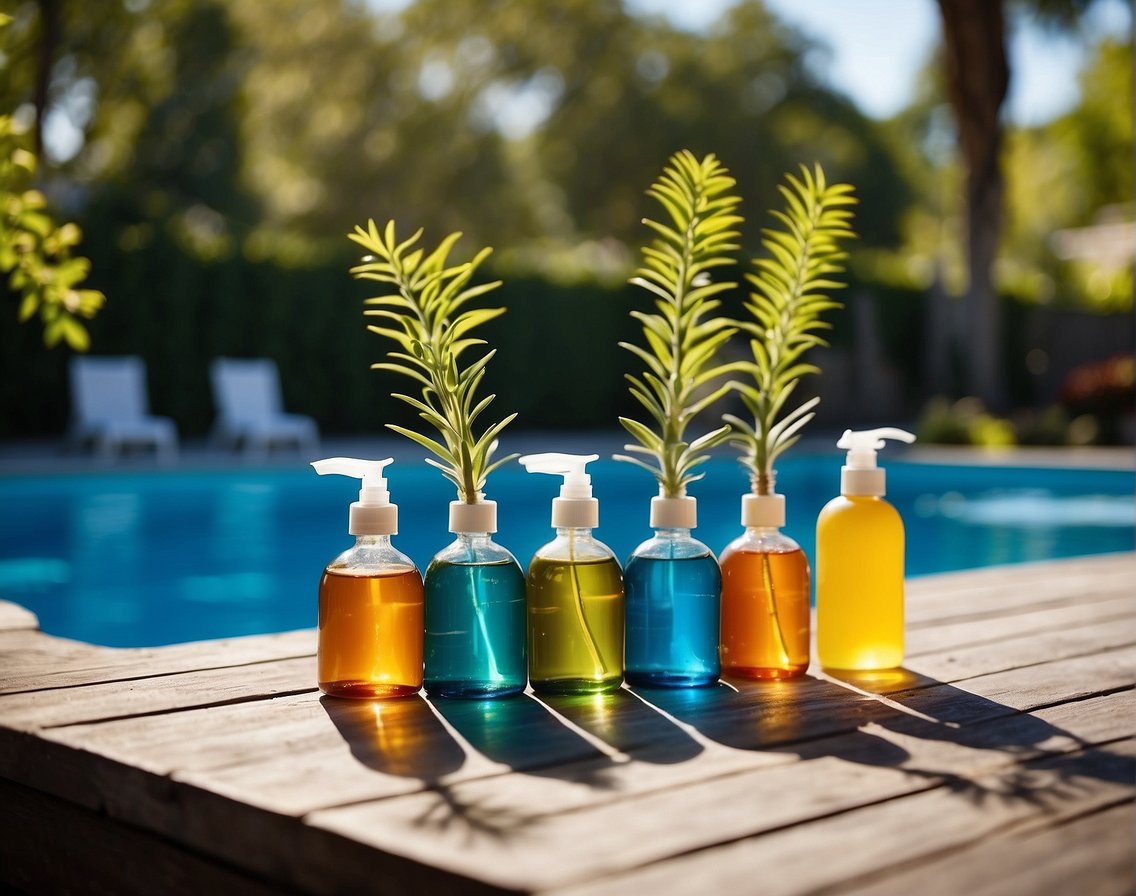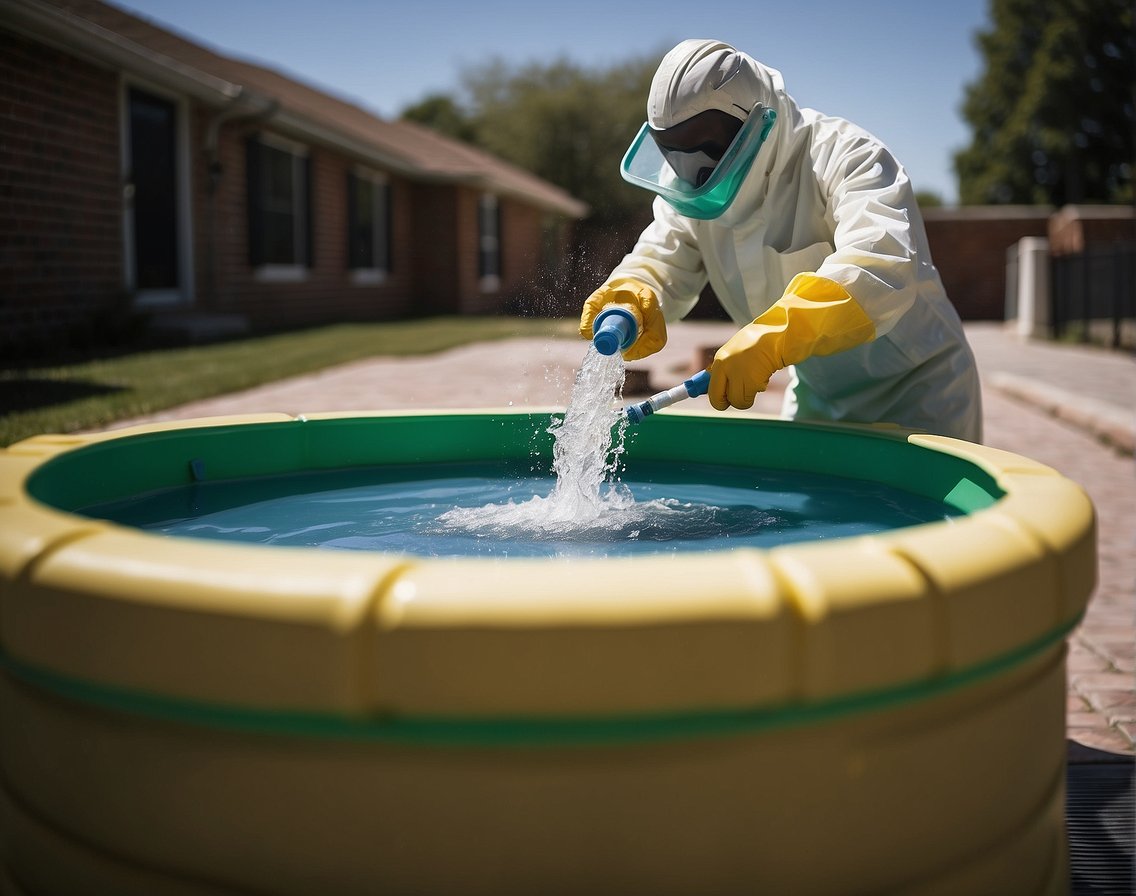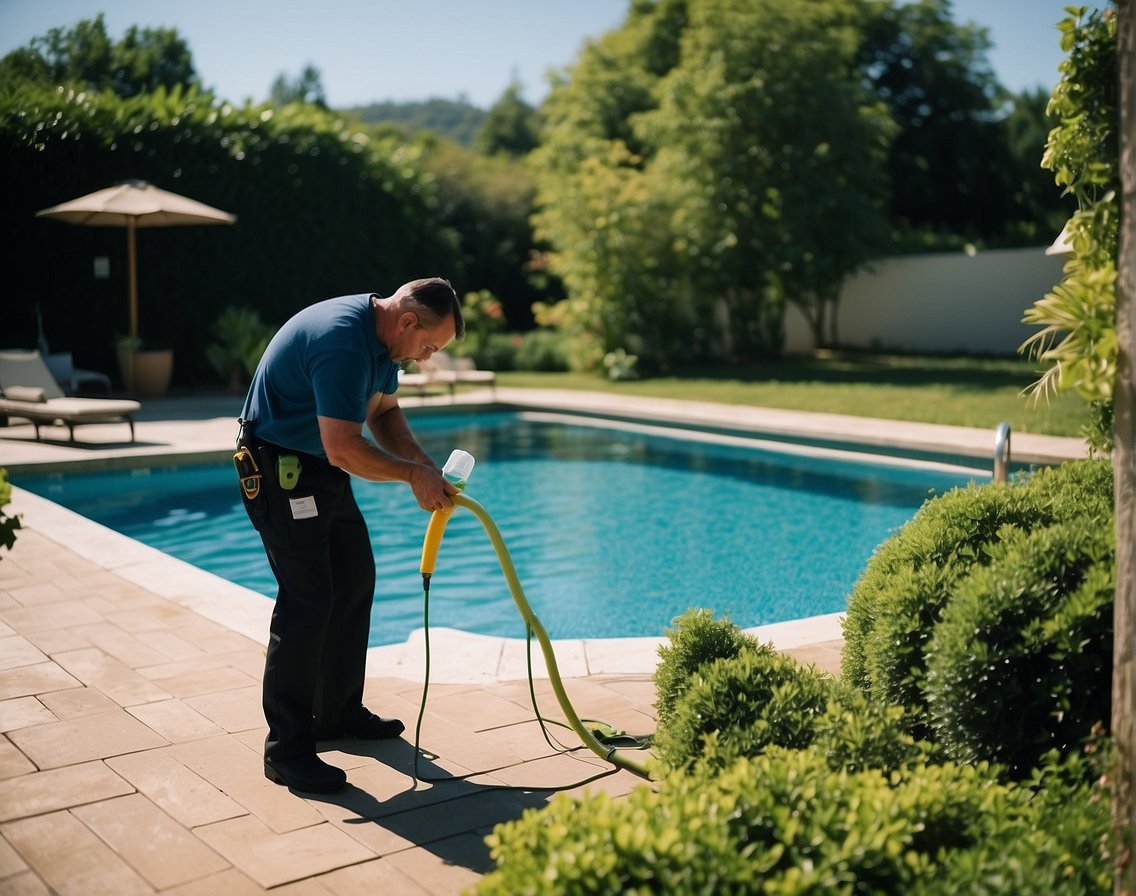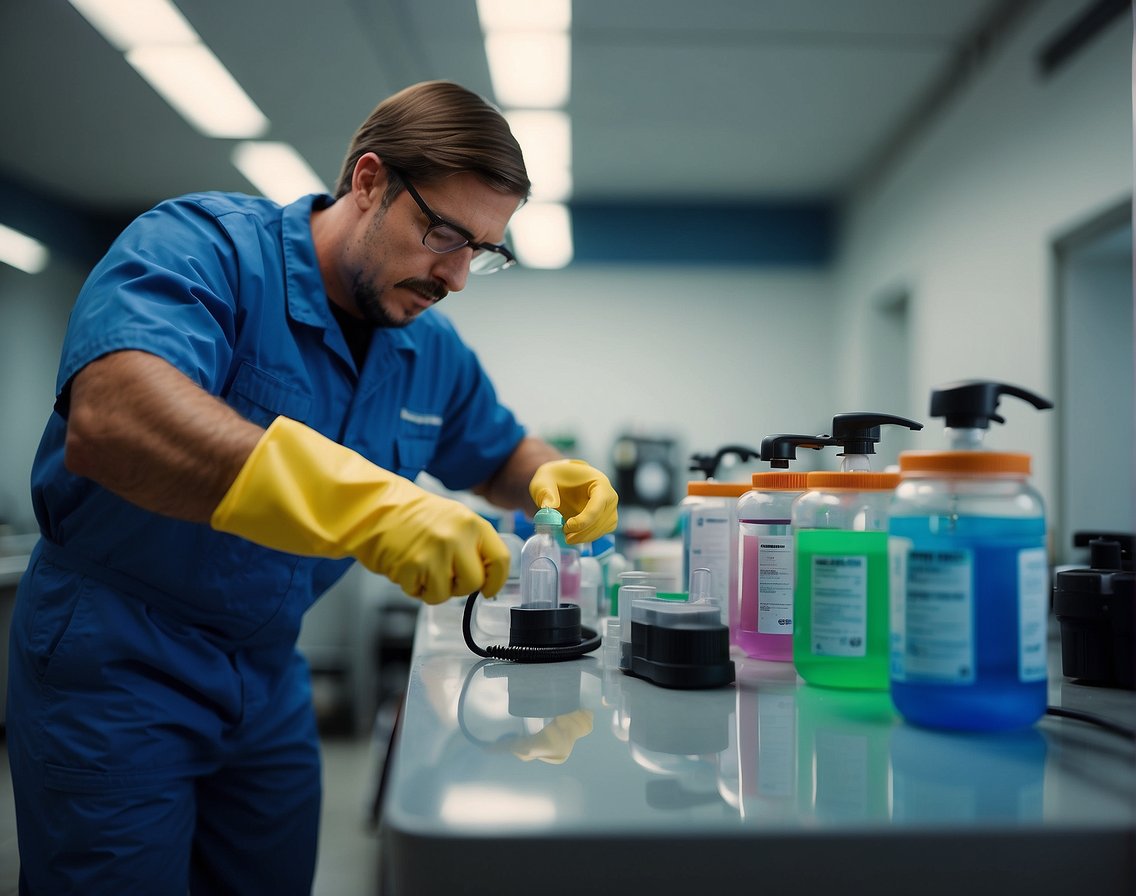Understanding Pool Chemistry

To maintain a healthy and enjoyable swimming environment, we need to closely monitor and adjust pool water chemistry. Let’s explore the crucial components.
Balancing Water Chemistry
In balancing water chemistry, pH levels, total alkalinity, and calcium hardness are fundamental to our pool’s water balance. We want to ensure pH levels stay between 7.2 and 7.8, as this range is comfortable for swimmers and helps sanitizers work effectively. Total Alkalinity, ideally between 80 to 120 ppm, acts as a buffer for pH, preventing large fluctuations. For calcium hardness, targeting 200 to 400 ppm avoids potential damage to the pool and discomfort for swimmers.
- pH: 7.2 – 7.8
- Total Alkalinity (TA): 80 – 120 ppm
- Calcium Hardness: 200 – 400 ppm
Cyanuric Acid assists in protecting chlorine from sunlight degradation and should be maintained at 30 to 50 ppm. Meanwhile, Total Dissolved Solids (TDS) refer to all elements dissolved in the pool, such as minerals, salts, and metals, and should be kept as low as possible to maintain the integrity of the pool water.
- Cyanuric Acid: 30 – 50 ppm
- Total Dissolved Solids (TDS): As low as possible
Role of Sanitizers
Sanitizers like chlorine and bromine are essential to destroy pathogens and prevent algae growth. Free chlorine levels should be maintained at 1 to 3 ppm, while bromine should be at 3 to 5 ppm for effective sanitation. It’s crucial to understand the different forms of chlorine in the pool:
- Free Chlorine: The amount of chlorine available to sanitize the water.
- Total Chlorine: The sum of free chlorine and combined chlorine.
- Combined Chlorine (Chloramines): Chlorine that has combined with ammonia or other contaminants, contributing to the “chlorine smell” and less effective sanitizing.
- Chlorine levels:
- Free Chlorine: 1 – 3 ppm
- Total Chlorine: Should be roughly equal to free chlorine levels
- Combined Chlorine: As low as possible
Regular testing and adjusting must be conducted to ensure levels of these sanitizers remain optimal for a clean and safe swimming experience. It’s also important for us to be aware of the Langelier Saturation Index (LSI), which helps us assess the water’s propensity for corrosion or scaling, based on water balance factors. By keeping this index within a neutral range, we can prevent both damage to our pool and ensure the comfort of swimmers.
Maintaining Pool Health

We understand that a healthy swimming pool is essential for the comfort and safety of its users. Ensuring that algae and bacteria are effectively controlled and common issues are avoided is paramount for maintaining pool health.
Controlling Algae and Bacteria
To prevent outbreaks and maintain clear pool water, regular testing is key. We must monitor chlorine levels to maintain a range typically between 1-3 ppm, as it is the primary disinfectant that kills harmful contaminants. Should algae begin to appear, a shock treatment with a higher chlorine concentration is effective, followed by the use of an algaecide. It’s essential to utilize these products as directed to avoid harmful side effects.
- Chlorine Levels: 1-3 ppm for effective sanitization
- Algaecide: Use post-shock treatment
For bacteria control, routine maintenance is our best defense. This includes maintaining a balanced pH, usually between 7.2 and 7.8, preventing scaling and corrosion. Also, we ensure filtration systems are run daily and cleaned regularly to remove any physical contaminants.
- pH Levels: 7.2-7.8 to prevent bacteria growth and protect equipment
- Filtration: Run and clean daily
Avoiding Common Issues
Issues such as scaling, corrosion, and discomfort for swimmers can arise from imbalanced pool chemistry. To prevent scaling—a buildup of minerals on pool surfaces—we keep calcium hardness levels in check, ideally between 200-400 ppm. To reduce the risk of corrosion, we avoid overly acidic conditions by maintaining the recommended pH and alkalinity levels.
- Calcium Hardness: 200-400 ppm to prevent scaling
- pH and Alkalinity: Maintain appropriate levels to protect against corrosion
By systematically managing these parameters and using pool maintenance schedules, we prevent common problems and keep the pool environment safe and inviting for all users.
- Maintenance Schedules: Follow diligently to deter issues before they arise
Pool Chemical Handling and Safety

When we manage swimming pools, it’s crucial to handle chemicals with precision and care. This means observing safety protocols and utilizing personal protective equipment accurately. Here, we provide guidelines on the proper usage of pool chemicals and outline essential PPE and compliance measures.
Proper Usage of Chemicals
- Muriatic Acid: To lower pH levels, we use this acid carefully, pouring into deep water, away from pool sides to avoid damage.
- Soda Ash: This alkalinity increaser is added to raise pH levels. It should be distributed evenly across the pool surface.
- Calcium Chloride: To increase water hardness, we dissolve granules in a bucket of water before adding to the pool to prevent cloudiness.
Mixing Precautions
Never mix chemicals together. We add each chemical to the pool separately, ensuring we avoid dangerous reactions.
| Chemical | Purpose | Handling Precautions |
|---|---|---|
| Muriatic Acid | pH decreaser | Always add acid to water, not water to acid. Use in well-ventilated areas. |
| Soda Ash | pH increaser | Dissolve in water first; apply gradually. |
| Calcium Chloride | Hardness increaser | Pre-dilute and add slowly to prevent clouding. |
PPE and Compliance
Personal Protective Equipment (PPE)
We always wear appropriate PPE when handling pool chemicals. This includes:
- Safety goggles
- Chemical-resistant gloves
- Long-sleeved clothing
Compliance
To maintain safety, we comply with guidelines set forth by OSHA and other relevant regulatory bodies.
| PPE Component | Usage |
|---|---|
| Goggles | Protect eyes from splashes |
| Gloves | Shield hands from direct contact with chemicals |
| Clothing | Prevent skin exposure to hazardous substances |
By adhering to these specific practices, we ensure the safety of ourselves and others while maintaining an optimal swimming environment.
Advanced Pool Balancing Techniques

To maintain pristine pool water quality, it’s essential to leverage modern sanitization methods and fine-tune water balance. These techniques ensure safe and enjoyable swimming while minimizing environmental impact.
Modern Sanitization Methods
Salt generators and mineral systems represent the cutting edge of pool sanitation. Salt generators work by converting salt to chlorine, thereby eliminating the need for traditional chlorine products. This method is not only gentler on the skin and eyes but also reduces the presence of chloramines, which are harmful by-products of chlorine. On the other hand, mineral systems utilize elements like silver and copper, which possess natural antimicrobial properties, reducing the reliance on chemical sanitizers.
To effectively manage these systems, it’s crucial to use an accurate testing kit or pool testing strips. These tools help us monitor levels of chlorine, pH, and other critical water balance parameters, such as alkalinity and hardness.
| Sanitization Technique | Description | Pros |
|---|---|---|
| Salt Generators | Converts salt to chlorine | Fewer chloramines, gentle on skin |
| Mineral Systems | Uses elements with antimicrobial properties | Natural sanitation, less chemical dependency |
Fine-tuning Water Balance
Fine-tuning water balance involves making precise adjustments to your pool’s chemical levels to ensure optimal water quality. Our testing kits or pool testing strips are indispensable here, as they offer us the details required for precise calibration. We utilize these kits to check for free chlorine, total alkalinity, and pH balance.
Fine adjustments can be made using chemicals like biguanide, an alternative sanitizer to chlorine, or by altering the pH with sodium bicarbonate (baking soda) or muriatic acid. Our intricate understanding of water chemistry allows us to alter the balance with minimal environmental impact.
Here’s a quick guide for checking water balance parameters:
- pH levels: should be between 7.4-7.6
- Total alkalinity: typically should be between 100-150 ppm (parts per million)
- Calcium hardness: ideal range is 200-400 ppm
Remember, regular testing and adjustments are the hallmarks of advanced pool management and ensure a safe, crystal-clear swimming experience.
Equipment and Tool Essentials

To manage a safe and environmentally conscious swimming pool, we need reliable equipment and an understanding of their impact on pool chemistry.
Overview of Pool Instruments
In our arsenal, essential instruments include a variety of tools dedicated to maintenance and testing. For precise chemical management, we rely on:
- Test kits: These are vital for determining the levels of chlorine, pH, alkalinity, and other chemical components in the pool water.
- Thermometers: Monitoring pool temperature is crucial as it affects both swimmer comfort and chemical efficiency.
- Saturation index calculators: These help us assess the water balance, which is important to prevent corrosion or scaling of pool surfaces and equipment.
Impact on Pool Chemistry
The tools we use directly affect pool chemistry:
- Pool filters: They play a role in removing contaminants, which can influence the effectiveness of balance pool chemicals.
- Ladders and other fixtures: Their material composition can introduce variables that we must account for when balancing the water.
Through vigilant use of these instruments, we ensure the longevity of pool equipment and the safety of swimmers.
Frequently Asked Questions
In balancing pool chemicals, it’s crucial we consider not only the purity of the water but also the long-term health of our environment.
What factors should be considered to minimize environmental impact when balancing pool chemicals?
We must consider the type and quantity of chemicals used, their breakdown products, and the potential for runoff into natural water bodies. Choosing chemicals that are both effective and have a reduced environmental impact is a delicate balance we need to achieve.
How can you accurately calculate the amount of chemicals needed for a pool while being environmentally responsible?
We employ precise testing of the water’s pH, alkalinity, and sanitizer levels to determine the exact chemical needs. This approach prevents us from over- or under-dosing, which can lead to waste or insufficient sanitation.
In what ways can standard pool treatment practices be altered to reduce their ecological footprint?
We can shift to practices like using variable-speed pumps, energy-efficient heaters, and solar covers to reduce energy use. More environmentally friendly sanitation methods, such as saltwater systems, can also reduce our reliance on harsh chemicals.
What are the risks of improper pool chemical use to the surrounding environment?
Improper use or overuse of pool chemicals can lead to contamination of soil and nearby water bodies, potentially harming aquatic life. Nutrient overloading from excess chemicals can also contribute to algal blooms, which deplete oxygen in water and kill fish.
Are there eco-friendly alternatives to traditional pool chemicals that are effective in maintaining water balance?
Yes, eco-friendly alternatives such as mineral purifiers, ozone, and UV purification systems are effective. These systems often require fewer chemicals and thus have a smaller environmental footprint.
How does overuse of pool chemicals affect local water sources and wildlife?
Overuse of pool chemicals can lead to chemical runoff, affecting the pH and toxicity of local water bodies. This runoff can be detrimental to plants, fish, and other wildlife, disrupting local ecosystems.
